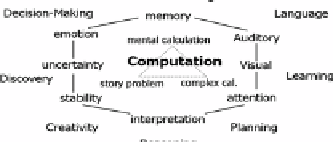Information Technology Reference
In-Depth Information
beyond specificity of a certain application and straightly models related domain
knowledge based on multiple core issues of BI methodology, including systematic
investigation, systematic experimental design, systematic data storage (the base
of systematic data management), and systematic data analysis and simulation.
3.2
A Multi-dimension Framework of Data-Brain
Based on systematic BI methodology, we design a multi-dimension framework of
Data-Brain as shown in Fig. 1, including four dimensions and multiple conceptual
views. We only give two conceptual views, the reasoning centric view and the
computation centric view, as examples in Fig. 1 because of the limitation of
space.
Conceptual View
Æ
Structural View
Conceptual View
Æ
Structural View
Function Dimension
Experiment Dimension
Analysis Dimension
has-experimental-purpose
has-result-data
has-result-data
has-origin-data
Data Dimension
1
Fig. 1.
A multi-dimension framework of Data-Brain
Firstly, the Data-Brain provides multiple conceptual views of systematic in-
vestigation of human thinking centric cognitive functions. The capabilities of
human intelligence can be broadly divided into two main aspects: perception
and thinking. Our BI study focuses on the “thinking centric” cognitive func-
tions, which are complex and closely related to each other. Thus, we need to
construct various conceptual views which illustrate systematic BI investigation
and their inter-relationships from different viewpoints based on functional re-
lationships among related human cognitive functions. These conceptual views
can be regarded as cognitive/brain scientists' interfaces to facilitate their own
research activities and cooperation with different focusing and research issues.
Figure 2 gives an abstract representation of the conceptual view, which il-
lustrates reasoning centric, thinking oriented BI investigation and their inter-
relationships based on functional relationships among related human cognitive
functions. The core issue is to investigate human deduction, induction, and ab-
duction related reasoning mechanisms, as well as including commonsense rea-
soning, as shown in the central of Fig. 2. Heuristic search, attention, emotion





































